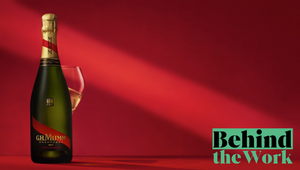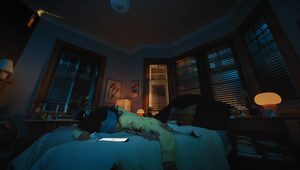
In ‘ASSIMULATION’ Les Garçons Embrace the Technology Making Them Anxious

The artistic duo Les Garçons brings a photographic eye to directorial work, both in artistic and commercial spheres. One necessarily feeds the other, pushing ideas further. Represented by the production company L’ÉLOI, Les Garçons’ work is playfully bold, with a striking use of colour and subtle sensuality.
Les Garçons latest project is the conceptual and abstract short film, ‘ASSIMULATION’ created as part of L’ÉLOI’s Lab – the company’s guarantee to its artists that they will be supported and encouraged in their creative experiments.
‘ASSIMULATION’ is experimental, in subject matter and execution too. Sensitive to the ongoing conversations around technological advancements and global unrest, Les Garçons’ film interrogates what happens when nature has had enough and decides to enact her revenge on humanity. It tells the story of an imaginary future where the remains of humanity are sheltered on the edge of a world they have poisoned. With no defence against the encroaching wilderness, they escape by uploading digital clones of themselves into a giant library of simulations. It’s set to a track of natural and synthetic sounds to further echo these ideas, mirrored by the rhythms and mix of Joseph Sims’ original music.
The results are unnerving and paranoid with visuals situated in surreal retrofuturistic surroundings which, for Les Garçons, connect the present moment with the 1970s, a period in history marked by similar anxieties to now, when budding progress and social change promised a brighter, better future.
The film started its life as a series of still photos Les Garçons took on their travels in London (where they stayed at the Standard hotel, a ‘70s era Brutalist gem), Mexico City, Toronto, and Montreal. Looking at the photos, Les Garçons wanted to bring them to life and AI had the capability to help them do it. It also provided another layer of tension – using technology that the film is sceptical of in order to create it. The process wasn’t easy as the duo experienced the limitations of generative AI’s abilities and through that Les Garçons became assuaged, at least for now, about AI’s applications in creative settings. “In a way, it's reassuring because we've benefited from the advantages of the tools, but we also clearly saw its limitations, and it gives us more confidence that it's simply a tool like anything else,” they add.
LBB’s Zhenya Tsenzharyk speaks to Les Garçons to learn more about the short film, their creative process, and what it was like to work with the very technology they’re concerned is forever altering contemporary image-making processes.
LBB> What inspired ‘ASSIMULATION’, when did the idea first come to you?
Les Garçons> This project was inspired by a very specific experience we had last year. We were staying at the Standard hotel in London for a week - a masterpiece of brutalist architecture – and the 1970s design of the lounge plunged us into the mindset of that decade. The birth of environmentalism, the threat of nuclear war, and the exciting new promise of technology.
Through the eyes of that time, we looked at our world today — there were rumours that Russia might launch nuclear missiles on Ukraine, the planet is still warming, and our relationship to technology has become a threat all its own. We talked about all of this for five nights while eating and drinking and listening to Peruvian jungle techno, and hatched the idea of portraying our current reality as a dystopian future imagined in the 1970s.
LBB> What themes and concepts did you want to explore with this imagery?
Les Garçons> There’s a ‘human versus nature’ part of the story. Giant tropical plants press in on the glass walls of the Standard’s terrace in the most menacing way — this gave us the idea of Nature finally getting fed up with humanity, and coming for revenge. Overtaking our cities, coming into our homes, sending us new viruses faster than we can create vaccines. Our relationship to our environment is even more important today than it was back then.
It’s also a ‘human versus machine’ story. Our main character escapes the encroaching wilderness by uploading copies of himself into a giant machine, and this is our second theme — technology as a saviour, or a bridge to some kind of immortal, transhuman existence.
There’s a distinct retro-futuristic look to the project.

We’re both children of the ‘70s, and grew up with a very analogue vision of what the future would look like – monolithic architecture, bodysuits, cloning, artificial food, all that great stuff. We were really excited about telling a story that looks into the future from a point in the past. The locations where we shot our photographs all express this analogue aesthetic - a mid-century mansion in Montreal, the Cold War Museum (the ‘Diefenbunker’) in Ottawa, and the spectacular Biblioteca Vasconcelos library in Mexico City. The library looks like a giant computer constructed out of floating shelves of books, and in our story, it’s a self-aware machine that talks to the characters through text prompts.
LBB> You used AI to turn your photographs into moving images. Can you discuss the process of using AI?
Les Garçons> This project started off as a series of five still photos, but we quickly realised we needed more to tell our story, and that it would be more interesting as a motion piece. We started experimenting with some AI tools, and introduced the musical component, and it was like the project exploded in front of our eyes. The motionless characters came to life, the camera started moving within the still frames, the music filled the story with ominous dread. It started to feel like the opening sequence of a Netflix series, where you see the characters and the context, and some clues about where the story will go, and that’s what we wanted. These AI tools helped us turn the original series of photos into the impressionistic story we really wanted to tell.
LBB> What was it like working with AI tools: Runway, Luma, and Midjourney?
Les Garçons> Like all image-makers, we’re suspicious of AI and the threats it poses to our industry. Our approach, with a few exceptions, was to start with stills captured in camera and processed in Photoshop to create the colour treatment and light leaks that give the project its visual signature. This is really hard to do when you’re starting from scratch and using text prompts to generate images. It’s hard to make small, specific adjustments using AI alone.
We discovered that the tools are a lot more primitive and unpredictable than all the hype would have you believe. And we noticed right away that the strange distortions and creepy artifice they often create really served our story. While the newly moving sequences felt somewhat like video, there was an inherent strangeness in the way they moved. The visual discomfort really added to the dystopian story we set out to tell.

We found that it was useful to a point that sometimes the renderings and the camera movements that the AI introduced were interesting, but sometimes they were completely useless, and especially very difficult to control and predict. Some of the mistakes that AI made were interesting, some of the mistakes were unusable, but some of them were a happy surprise where they were actually quite interesting. It's extremely time consuming, because you have to render and iterate dozens and hundreds of tests before you get something that's useful.
The tools helped us break a creative barrier and turn the photos into a more of a story that we were very satisfied with, but they also really reassured us. I think a lot of people in the image making industry right now are afraid that next year we're going to be making Hollywood blockbuster films with AI, and everyone's going to be out of a job. But we're years, like we're years and years, away from that. And in a way, it's reassuring because we've benefited from the advantages of the tools, but we also clearly saw their limitations.
LBB> What’s the significance of the title of the project, ‘ASSIMULATION’?
Les Garçons> If you look closely at some of the closeups of the main characters, you see them turn from real people in real photos to simulated people in AI-generated images. The AI sucks the life out of them, right before your eyes. The main character’s unique human-ness is assimilated, and he becomes many simulations of himself. One of the main concerns about AI right now is the danger of deepfakes and the possible eventuality that we won’t be able to distinguish the real from the simulated. This project purposefully blurs that line.

From a personal point of view, you could say that we were using this story about the ominous power of technology in a fictional world to work through our ambivalent feelings about the growing role of AI in our industry. Quite meta actually. In the end, we prefer to leave room for viewers to make their own interpretations and come to their own conclusions about these questions. But in our opinion, AI isn’t taking over the image-making industry any time soon.















